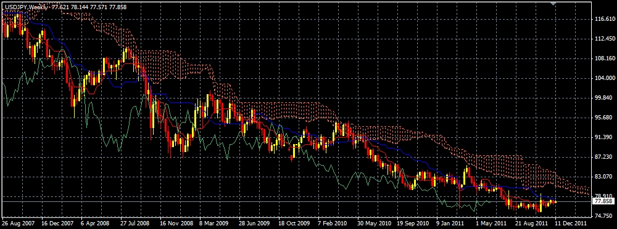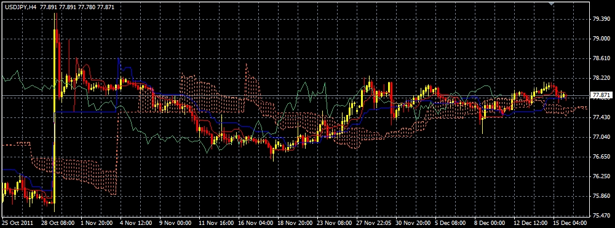
The CleanFinancial guide to USD/JPY spread betting.
- Where Can I Spread Bet on USD/JPY?
- Live USD/JPY Charts
- Live USD/JPY Prices
- USD/JPY Trading News and Analysis
- Where Can I Trade USD/JPY for Free?
- Where Can I Practice Trading USD/JPY?
- How to Spread Bet on USD/JPY?
- Forex Spread Betting Guide
- JPY Commitments of Traders Report
- USD/JPY Price Comparison
- USD/JPY Technical Analysis Case Study
Live USD/JPY Chart & Prices
The CFD trading chart below will also give users a valuable guide to the USD/JPY market.The Plus 500 chart above usually shows the USD/JPY futures price (not the daily market).
If you want to check live spread betting charts and the current prices for USD/JPY, you will normally need a spread trading account.
Also, a spreads account lets you trade on the shorter term spot markets. Note that spreads accounts are subject to credit and status checks.
If your account application is approved then you can log on to study the real time charts/prices. These are normally provided for free. So what’s the catch? You are likely to get an occasional boring sales call or dull letter from your spread betting company.
Of course, if you were to trade then you should note that CFD trading and spread betting do carry a high degree of risk to your capital and can result in losses that exceed your initial deposit.
USD/JPY Comparison
A forex comparison table covering USD/JPY and other popular markets:Typical In-Hours Spread Sizes |
 |
 |
 |
 |
| EUR / USD Daily | 0.7 | 1 | 0.7 | 0.7 |
| GBP / USD Daily | 1 | 1.5 | 0.9 | 0.9 |
| EUR / GBP Daily | 0.8 | 1.3 | 1.5 | 0.9 |
| USD / JPY Daily | 0.8 | 1 | 0.9 | 0.7 |
| Forex – Minimum Stake | £1 | £1 | £0.5 | £1 |
USD/JPY Market Analysis and Trading News
5 May 2018, 12:56pm, Updated Japanese Yen COT Report
The latest Commitments of Traders Report (COT) for the Japanese Yen has been released by the CFTC, please see our Japanese Yen COT report below.
Readers should note that we have also updated our Forex COT Summary Report.
The latest Commitments of Traders Report (COT) for the Japanese Yen has been released by the CFTC, please see our Japanese Yen COT report below.
Readers should note that we have also updated our Forex COT Summary Report.
5 May 2018, 8:17pm, Updated Japanese Yen COT Report
The latest Commitments of Traders Report (COT) for the Japanese Yen has been released by the CFTC, please see our Japanese Yen COT report below.
Readers should note that we have also updated our Forex COT Summary Report.
The latest Commitments of Traders Report (COT) for the Japanese Yen has been released by the CFTC, please see our Japanese Yen COT report below.
Readers should note that we have also updated our Forex COT Summary Report.
» More forex trading views and analysis.
This content is for information purposes only and is not intended as a recommendation to trade. Nothing on this website should be construed as investment advice.
Unless stated otherwise, the above time is based on when we receive the data (London time). All reasonable efforts have been made to present accurate information. The above is not meant to form an exhaustive guide. Neither CleanFinancial.com nor any contributing company/author accept any responsibility for any use that may be made of the above or for the correctness or accuracy of the information provided.
Unless stated otherwise, the above time is based on when we receive the data (London time). All reasonable efforts have been made to present accurate information. The above is not meant to form an exhaustive guide. Neither CleanFinancial.com nor any contributing company/author accept any responsibility for any use that may be made of the above or for the correctness or accuracy of the information provided.
Where Can I Trade USD/JPY for Free?
All trading involves a degree of risk. Nevertheless, if you would like to open a free Test Account, where you can access candlestick charts and practice your financial spread betting, see below.When thinking about which investment option is right for you, also remember that financial spread betting in the UK is currently tax free*, i.e. it is exempt from income tax, capital gains tax and stamp duty.
If you are trying to find a free forex trading site then keep in mind that investors can trade USD/JPY with no commissions and no brokers’ fees at:
Free Demo Account
If you want a free Demo Account where you can practice spread betting, including forex markets such as USD/JPY, then you could always have a look at:These companies currently provide a Test Account that lets users check charts, test trading ideas and gain experience with trading orders.
How to Spread Bet on USD/JPY?
As with a wide variety of financial markets, you can speculate on currency rates, such as USD/JPY, to either increase or decrease.If we go to Financial Spreads, we can see they have put the USD/JPY Rolling Daily market at ¥77.804 – ¥77.812. As a result, you could spread bet on the USD/JPY currency rate:
 Moving above ¥77.812, or
Moving above ¥77.812, or Moving below ¥77.804
Moving below ¥77.804Whilst placing a spread bet on USD/JPY you trade in £x per point where a point is ¥0.010 of the pairs movement. So, should you decide to invest £4 per point and USD/JPY moves 41.0 points then that would make a difference to your bottom line of £164. £4 per point x ¥0.410 = £4 per point x 41.0 points = £164.
Rolling Daily Forex Markets
You should note that this is a ‘Rolling Daily Market’, therefore there is no set closing date for this market. If you leave your trade open at the end of the day, it will roll over to the next session.If a forex spread bet is rolled over then you will pay a small overnight financing fee. For more details on overnight charges and a fully worked example read Rolling Daily Spread Betting.
USD/JPY Trading Example 1
If you consider the spread of ¥77.804 – ¥77.812 and assume that:- You have done your analysis of the foreign exchange markets, and
- You feel that the USD/JPY market will push above ¥77.812
So, you make a profit of £2 for every point (¥0.010) that the USD/JPY FX pair pushes higher than ¥77.812. Having said that, you will lose £2 for every point that the USD/JPY market decreases below ¥77.812.
Put another way, if you buy a spread bet then your profits (or losses) are found by taking the difference between the settlement price of the market and the initial price you bought the market at. You then multiply that price difference by the stake.
As a result, if after a few trading sessions the foreign exchange rate started to rise you might decide to close your spread bet so that you can secure your profit. As an example, should the market rise, the spread might change to ¥78.279 – ¥78.287. You would settle/close your trade by selling at ¥78.279. Accordingly, with the same £2 stake your profit would be:
Profits (or losses) = (Closing Price – Opening Price) x stake
Profits (or losses) = (¥78.279 – ¥77.812) x £2 per point stake
Profits (or losses) = ¥0.467 x £2 per point stake
Profits (or losses) = 46.7 points x £2 per point stake
Profits (or losses) = £93.40 profit
Speculating on currencies, whether by spread betting or otherwise, may not go to plan. In this example, you had bet that the forex pair would increase. Naturally, the forex rate can also fall.
If the USD/JPY rate weakened, against your expectations, then you could choose to close your trade to stop any further losses.
Should the spread fall back to ¥77.267 – ¥77.275 then you would close your trade by selling at ¥77.267. As a result, your loss would be:
Profits (or losses) = (Closing Price – Opening Price) x stake
Profits (or losses) = (¥77.267 – ¥77.812) x £2 per point stake
Profits (or losses) = -¥0.545 x £2 per point stake
Profits (or losses) = -54.5 points x £2 per point stake
Profits (or losses) = -£109.00 loss
Note: USD/JPY Rolling Daily market accurate as of 11-Sep-12.
Advert:
USD/JPY Spread Betting, sponsored by FinancialSpreads.com.
You can spread bet on USD/JPY with Financial Spreads.
You can spread bet on USD/JPY with Financial Spreads.

How to Spread Bet on Dollar-Yen – Example 2
If we go to a financial spread betting platform like FinancialSpreads, we can see that they are currently pricing the Dollar-Yen Rolling Daily market at ¥78.615 – ¥78.623. This means you can spread bet on the Dollar-Yen foreign exchange rate: Increasing above ¥78.623, or
Increasing above ¥78.623, or Decreasing below ¥78.615
Decreasing below ¥78.615When spread betting on the Dollar-Yen pair you trade in £x per point where a point is ¥0.010 of the pairs movement. So, if you staked £5 per point and Dollar-Yen moves 24.0 points then that would be a difference to your profit/loss of £120. £5 per point x ¥0.240 = £5 per point x 24.0 points = £120.
If you think about the above spread of ¥78.615 – ¥78.623 and make the assumptions that:
- You have analysed the FX markets, and
- Your analysis leads you to feel that the Dollar-Yen market will push higher than ¥78.623
With this trade you gain £3 for every point (¥0.010) that the US Dollar-Japanese Yen rate pushes above ¥78.623. Having said that, you will lose £3 for every point that the Dollar-Yen market goes below ¥78.623.
Put another way, if you ‘Buy’ a spread bet then your P&L is worked out by taking the difference between the closing price of the market and the initial price you bought the spread at. You then multiply that difference in price by your stake.
Therefore, if after a few trading sessions the forex pair started to increase, you might think about closing your position so that you can secure your profit.
Taking this a step further, if the market rose then the spread, determined by the spread betting firm, could change to ¥79.020 – ¥79.028. In order to close your position you would sell at ¥79.020. So, with the same £3 stake you would calculate your profit as:
Profit / loss = (Closing Level – Opening Level) x stake
Profit / loss = (¥79.020 – ¥78.623) x £3 per point stake
Profit / loss = ¥0.397 x £3 per point stake
Profit / loss = 39.7 points x £3 per point stake
Profit / loss = £119.10 profit
Speculating on the FX markets is never straightforward. In this case, you had bet that the forex rate would rise. Of course, the FX rate can also fall.
If the US Dollar-Japanese Yen rate had fallen then you could choose to close your spread bet in order to restrict your losses.
So if the market fell to ¥78.171 – ¥78.179 then you would close your trade by selling at ¥78.171. Accordingly, your loss would be:
Profit / loss = (Closing Level – Opening Level) x stake
Profit / loss = (¥78.171 – ¥78.623) x £3 per point stake
Profit / loss = -¥0.452 x £3 per point stake
Profit / loss = -45.2 points x £3 per point stake
Profit / loss = -£135.60 loss
Note – Dollar-Yen Rolling Daily spread betting market quoted as of 18-Sep-12.
Advert:
USD/JPY Spread Betting, sponsored by FinancialSpreads.com.
You can spread bet on USD/JPY with Financial Spreads.
You can spread bet on USD/JPY with Financial Spreads.
Japanese Yen Commitments of Traders Report – 15 May 2018 (i)
Futures Only Positions, CME , Code 97741, (Contracts of ¥12,500,000) (i)| Reporting Firms (i) | Non-Reportable Positions (i) | ||||||||
| Non-Commercial (i) |
Commercial (i) | Total Reportable (i) | |||||||
| Commitments (i) | Open (i) Interest | Commitments | |||||||
| Long (i) | Short (i) | Spreads (i) | Long | Short | Long | Short | Long | Short | |
| 64,926 | 61,246 | 3,457 | 69,058 | 65,583 | 137,441 | 130,286 | 163,411 | 25,970 | 33,125 |
| Changes from 8 May 2018 (i) | Change in (i) Open Interest | Changes from | |||||||
| Long | Short | Spreads | Long | Short | Long | Short | Long | Short | |
| 13,114 | 3,972 | -320 | -5,771 | -501 | 7,023 | 3,151 | 5,835 | -1,188 | 2,684 |
| Percent of Open Interest for Each Category of Trader (i) | |||||||||
| Long | Short | Spreads | Long | Short | Long | Short | Long | Short | |
| 39.7% | 37.5% | 2.1% | 42.3% | 40.1% | 84.1% | 79.7% | 15.9% | 20.3% | |
| Number of Traders in Each Category (i) | Total (i) Traders | ||||||||
| Long | Short | Spreads | Long | Short | Long | Short | |||
| 34 | 37 | 21 | 37 | 35 | 79 | 85 | 122 | ||
| Long/Short Commitments Ratios (i) | Long/Short Ratio | ||||||||
| Ratio | Ratio | Ratio | Ratio | ||||||
| 1.1:1 | 1.1:1 | 1.1:1 | 1:1.3 | ||||||
| Net Commitment Change (i) | |||||||||
| 9,142 | |||||||||
Also see:
Applying Technical Analysis to USD/JPY
Below, an older but still useful case study on the US dollar/Japanese yen market by Shai Heffetz, InterTrader, 16-Dec-2011.For a longer-term overview it is always useful to study a weekly chart; the candlestick chart below is a good example of the USD/JPY forex market, showing price movements for the past four years.
Looking at this chart it becomes clear that from a long-term perspective, the US dollar has been in a bear market for virtually the entire period.
Even the massive spike we saw towards the end of October, when the price jumped from a low of ¥75.555 to ¥79.519 does not really look significant on such a long-term chart.
The price is positioned below the Ichimoku cloud at present and the green Chinkou Span line is far below the price of 26 periods ago, confirming that the dollar is still in the grips of a long-term bear market.

Moving to a shorter-term view, the four-hourly chart below shows price movements since the end of October 2011.
We can see that the pair has been moving mainly sideways during this period, reaching a low of ¥76.562 on 18 November and a high of ¥78.270 on 29 November.
Right now it is hovering slightly above the Ichimoku cloud. The green Chinkou Span line is also marginally above the price 26 periods ago.
The chart would suggest that we are in a bull market, but we need more confirmation before a long trade can be advised.
If the price should move above the recent high of ¥78.270 we might see a short-term bull run, but given the fact that the longer-term bear market is still intact, this is unlikely to last long.
Any new low could mean the resumption of the underlying bear trend, providing a useful entry point for short traders.

Spread betting and CFD trading carry a high level of risk to your capital and you may lose more than your initial investment. Spread betting and CFD trading may not be suitable for all investors. Only speculate with money that you can afford to lose. Please ensure you fully understand the risks involved and seek independent financial advice where necessary.

